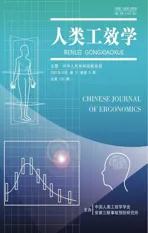Exploration on China's Institution-oriented Elderly CareService System Based on Human Factors Engineering
2022-01-15YANGXIANFANGTANAKATOYOJI
YANG XIAN FANG ,TANAKA TOYO JI
(1.Graduate School Department of Life Support Science,Nishikyushu University, Saga-ken 842-8585,Japan;2. Department of Social Welfare Science,Nishikyushu University,Saga-ken 842-8585,Japan)
【Abstract】 Objective Aging process in China has brought more and more challenges to traditional home-based care for the aged and more attentions to the mode of institution-oriented elderly care.This work,by analyzing the problems and defects of institution engaging in elderly care based on the human factors engineering theory,discusses the people-centered institution-oriented elderly care service system,in terms of the problems that the pattern of institution-oriented elderly care focuses more on the facilities and environment construction than the principal role of people in the elderly care service system.Methods Sampled the institutions engaging in elderly care in Hefei City,Anhui Province,P.R.China (a medium-sized city in China); surveyed 45 institutions engaging in elderly care and 828 registered elders in Hefei City by hierarchical and systematic sampling method.Results (1) institutions engaging in elderly care shared the occupancy rate of 49.6% and low total service efficiency; (2) institutions engaging in elderly care offered 100% life-oriented service items,but only 6.1% personalized service items provided; (3) 100% simple housing facilities in elderly care institutions,but extremely less personalized service facility (3.2%),with poorer quality and less satisfaction; (4) insufficient professional service staff could be available; 48.1% institutions have 5 or less professional service staffs.Conclusion A countermeasure to improve the elderly care service system was raised here by aiming at improving the institution-oriented elderly care service:(1) to transfer service toward the people-oriented concept,formulating preferential policy for endowment insurance; (2) to pay attention to personalized design of service facility,offer personalized and featured service items,and improve service management level; (3) to build professional team for elderly care.
【Key words】 institution-oriented elderly care; personalized service; organizational behavior; aging of population; elderly care service system; endowment insurance
1.Introduction
Inrecentyears,thetideof“silverhair”hasswepttheglobe,wheretheagingofpopulationhasbecomeaseveresocialproblem.China,asthecountrywithalargepopulation,hasenteredthephaseof“agingbeforegettingrich”,andisfacedwiththeextremelysevereagingsituation.AccordingtotheresultsofTheSeventhNationalPopulationCensusofChina(May2021),thetotalpopulationofChinamainlandwas1,411,780,000,amongwhichthepopulationaged60yearsoldandabovewas264,020,000,accountingfor18.7%[1],whichisfarmorethantheinternationalstandardforaging(7%).Hugeold-agepopulationismakingthesheer“home-basedcarefortheaged”inthepastdifficulttoprovidelifesecurityfortheaged.Moreover,astheindustralization,urbanizationandlabormobility(liberalization)havedevelopedrapidly,thelivingbasisof“home-basedcarefortheaged”isfacedwithseverechallenges,andtherebythesocialpensionstyledominatedbyinstitution-orientedelderlycaresystememerges.BytheendofJune,2019,therewere29,900institutionsengaginginelderlycareservices,143,400institutionsandfacilitiesincommunityelderlycareservices,and7,353,000servicebedsfortheaged[2]inChina.Evenevery1,000oldpeopleowned28.9servicebeds,butaccordingtotheinternationalstandard,i.e.:averagelyevery1,000oldpeopleown50servicebeds,thereisstillhugegapintheservicebedsfortheagedinChina[3].However,thepopulationinneedofcareinChinawas33,000,000bytheendof2010,40,000,000by2015,anditisestimatedtobe170,000,000by2053[4].Asthenumberoftheagedneedingcareincreasesyearafteryear,thenumberofinstitutionsengaginginelderlycareinChinaisalsoincreasing.But,nowadays,someinstitutionsengaginginelderlycare,inordertoattracttheaged,focusonlyontheconstructionoffacilityandenvironment,insteadoftheneedsofoldpeoplefor“elderlycareservices”,theservicesandthespiritualpursuitconcernedauthenticallybytheaged,sothereisimbalanceinthesupplyanddemandofelderlycareservices.Inordertodeeplyunderstandandanalyzetheproblemsconstrainingthedevelopmentofinstitution-orientedelderlycarestyle,wesurveyedthecurrentsituationofelderlycareinstitutionsandtheregisteredoldpeopleintheinstutionsinChina,aimingatprovidingdecisionreferenceforthedevelopmentofChina’sinstitution-orientedelderlycareservicesystem.
2 Objects and methods
2.1 Research object
Earlyin1997,HefeiCityenteredtheagingsociety,whichwasearlierthanthewholecountryofChinabythreeyearsandoneyearearlierthanAnhuiProvince[5].AccordingtotheseventhnationalcensusofHefei(2021),thepermanentresidentpopulationinHefeiis9.3699million,anincreaseof1.913million,anincreaseof25.7%,andanaverageannualincreaseof2.3%,comparedwith7.457millioninthesixthnationalcensusin2010.ThepopulationofHefeihasincreasedrapidlyinthepast10years.Thepopulationaged60andoverwas1.43million,accountingfor15.3%,ofwhichthepopulationaged65andoverwas1.123million,accountingfor12%.Comparedwiththesixthnationalcensus,theproportionofthepopulationaged0-14increasedby1.9%,theproportionofthepopulationaged15-59decreasedby3.4%,theproportionofthepopulationaged60andoverincreasedby1.6%,andtheproportionofthepopulationaged65andoverincreasedby2.8%[6].Suchpercentagewasapproachingtothenationalaverage,soHefeiCityiswellrepresentative.Inthisstudy,Hefei,amedium-sizedcity,wasselectedastherepresentativesample.45institutionsengaginginelderlycarewereselectedrandomlyfromalistof165institutionsinHefeiCityaccordingtoadministrativedivisions4)andthebedscaleofinstitutionsengaging,wheretherewere37small-sizedinstitutionsengaginginelderlycare(200bedsavailable),6medium-sizedinstitutionsengaginginelderlycare(200~1,000bedsavailable)and2large-sizedinstitutionsengaginginelderlycare(morethan1,000bedsavailable).Theregisteredeldersin45institutionsengaginginelderlycarewerenumbered,andgroupedaccordingtotheirage,namelytheelderswereclassifiedasoneagegroupbyevery10yearsold.Onthebasisofensuringthenumberofeveryagegrouptobemorethan200andintotal800,thehierarchicalequal-proportionsystematicsamplingmethodwasadoptedaccordingtothebedscaleofinstitutionsengaginginelderlycare,therefore,total900elderswereselectedasthesurveysamples.Afterexcludingthesampleswithincompleteinformation,thereweretotally828effectivesamples(collectionrate92%)toberesearchobjectsofthiswork.Forthespecificsamples,seeTable1asfollows.

Table1 Composition of survey samples for elders in institution engaging in elderly care
2.2 Research method
WeconductedtheoperationsofdataentryandlogiccheckafterestablishingthedatabasewithEpiData3.1software,analyzedthesignificancedifferenceofvariousinfluencefactorsininstitution-orientedelderlycareserviceswithχ2,andfinallyconductedthemultiple-factoranalysisinvolvingthesatisfactionofinstitution-orientedelderlycareservicebythetwo-categoryLogisticregressionmodel,withmarchingmethodincorporatedandvariablesremoved.
2.3 Ethical review
Astatisticaltreatmentwasmadeforallcollecteddata,andtheissuethatinstitutionsandindividualshadnotbeenspecificallydesignatedwasalsoconsideredwhenpublishingresults.Besides,thissurveywasapprovedbytheEthicsCommitteeofNishikyushuUniversity,Japan(No.:20RNV03).Thesurveywentthrough4months(July2,2020~October28,2020).
3 Results
3.1 Analysis on current situation of institutions engaging in elderly care in Hefei City
3.1.1Occupancyrateininstitutionengaginginelderlycare
Uponthesurvey,therewere4,662eldersin45institutionsengaginginelderlycare,andtheaverageoccupancyratewas49.6%;inotherwords,halfofbedswerenotoccupied.Amongthem,higheroccupancyrateoccurredinthesmall-sizedandlarge-sizedinstitutionsengaginginelderlycare,i.e.:56.4%and56.7%respectively,buttheminimumoccupancyrateoccurredinthemedium-sizedinstitutionsengaginginelderlycare,i.e.:37.1%(fordetails,seeTable2).AsshowninTable2,thepatternofinstitution-orientedelderlycarewasnotyetwidelyacceptedbyChineseresidents;thelowoccupancyrateshowedtheinstitution-orientedelderlycareserviceefficiencywasatthelowlevel.

Table 2 Occupancy rate in institutions engaging in elderly care in Hefei City
3.1.2Serviceitemsininstitutionsforelderlycare
Accordingtothesurveyresultsofserviceitems,theserviceitemsofinstitutionforelderlycarewererathersimple,mainlythelifecareservices;theseservicesarehighlypopularized(100%),followedbyentertainmentserviceitems(62.7%),suchasreadingbooks,watchingTV,listeningtoradioetc.Howeverthehumanisticserviceitemswereless(6.1%only),includinginterest-orientedclass,healthcareservice,specialcareetc.(seeFig.1).

Fig.1 Composition of service items in institution engaging in elderly care
3.1.3Servicefacilitiesininstitutionsforelderlycare
Asawhole,theservicefacilitiesininstitutionsforelderlycarewererathersimple,mainlythelifefacilities;theselifefacilitieswerehighlypopularized(100%)followedbymedicalfirst-aidfacilities.However,therewerelesshumanisticservicefacilities(3.2%),andsmarthome,andmulti-functionalmedicalfacilitieswereless(seeFig.2).

Fig.2 Composition of service facilities in institution engaging in elderly care
3.1.4Professionalservicestaff
AsshowninFig.3,itcanbeseenthattherewerelessprofessionalservicestaffsintheinstitutionsforelderlycare.48.1%ofthoseinsurveyownfiveprofessionalservicestaffsorless,while11.4%own10professionalservicestaffsorabove.However,thequotabetweendoctor,nurse,nursingworkerandelderwasverylow,andthedemissionrateofmedicalworkerwashigh,indicatingthelowstabilityofmedicalworkerintheindustry.Moreover,managerialstaffandmedicalworkerintheseinstitutionshadrelativelyloweducationallevel,oldageandlongerworktime,reflectingthelowservicequalitylevelandsevereshortageofprofessionalservicestaff(seeFig.3).

Fig.3 Composition of service staff in institution engaging in elderly care
3.2 Analysis on influence factors of service satisfaction of institution engaging in elderly care
Bycomparingandanalyzingtheservicesatisfactionofeldersininstitutionsforelderlycareontheirservices,itisfoundthattheservicesystemofinstitutionsforelderlycare,suchasserviceitem,servicefacility,servicepersonnelallocationetc.,hadsignificancedifferenceintheservicesatisfaction(P<0.05),indicatingthatthefactorofservicesystemconstructionaffectedtheservicelevelofinstitutionengaginginelderlycaresignificantly(seeTable3).Besides,itisalsofoundtheindividualfactorofelderaffectedtheservicesatisfaction(P<0.05),namelythedissatisfactionofthefemaleelderwasobviouslyhigherthanthatofthemaleelder;thehighertheeducationallevelwas,thehigherthedissatisfactionwas;thedissatisfactionofthemarriedelderwashigherthanthatoftheunmarriedelder;thedissatisfactionoftheruralelderwashigherthanthatoftheurbanelder;thedissatisfactionofthehigh-incomeelderwashigherthanthatofthelow-incomeelder;thehighertheexpensefortheelderwas,thelowertheirsatisfactionwas(seeTable4).

Table 3 Analysis on influence of service system of institution engaging in elderly care on service satisfaction

Table 4 Analysis on influence of individual factor of elder in institution engaging in elderly care on service satisfaction
3.3 Multi-factor analysis on service satisfaction of institutions for elderly care
Accordingtotheresultsofsingle-factoranalysisonservicesatisfactionofinstitutionsforelderlycare,two-categoryLogisticregressionmodelwasadoptedtoconductthemultiple-factoranalysis,inwhichtheserviceitems,servicefacilities,servicestaffsinthefactorsofservicesystemconstructionofinstitutionsforelderlycare,andthegender,culture,maritalstatus,economysituation,homelocationintheindividualfactorofelderwereadoptedastheindependentvariables,whiletheservicesatisfactionofinstitutionengaginginelderlycarewasadoptedasthedependentvariable(satisfaction=0,dissatisfaction=1),withthemarchingmethodincorporatedandthevariablesremoved.Afterregulatingandcontrollingthelatentconfoundingeffectofothervariables,theresultsshowedthatthefactors,namelyelder’sgender,maritalexperience,homelocationandeconomysituation,hadmoresignificantinfluenceonsatisfaction(P<0.01),seeTable5.Thefactorofeconomysituation(monthlyincomelevel)hadmaximuminfluenceonsatisfaction;itsORvaluewas60.2anditscorrelationcoefficientβwasalsomorethan0,indicatingtheelderenjoyinghighmonthlyincomehad60.20timessatisfactionthanthatoftheelderenjoyinglowmonthlyincome.Similarly,femaleeldershad14.3timesdissatisfactionthanthatofmaleelders.Asshownbytheresultsofthiswork,institutionsforelderlycare,inadditiontoimprovingservicefacilityconstructionandpersonallevelofservicestaff,mustsimultaneouslyconsidertheeconomicconditions,individualdifference(gender,martialhistory,family)andpersonalizeddemandsoftheelders.Thismightbeoneofmainreasonswhyinstitution-orientedelderlycareservicesareusuallyindilemma.

Table 5 Multi-factor logistic regression analysis on satisfaction of elders in China for services of institution engaging in elderly care
4 Discussions
4.1 Traditional culture weakens indirectly the position of institution-oriented elderly care in elderly care service
The“cultureoffilialpiety”istherepresentativeelementofChina’straditionalculture.Theconceptof“bringingupsonstosupportparentsintheiroldage”isahiddenconcept,whichisrootedintheideologyofChinesepeople.Historically,Chinahasalwaysadoptedafamilypensionmodelwith"filialpietyculture"asthecoreand"home"asthecarrier[7].Bothofthemarethetideofhistoricaldevelopmentandalsobuildthecorepositionofhome-basedcarefortheaged.Inviewofexternalfactors,ifanelderleaveshis/herchildrenandlivesinoldpeople’shome,his/herchildrenmightbeconsidered“unfilial”.Moreover,manychildrenareworriedthattheymightbeblamedastheunfilialsonordaughterifsendingtheirparentstoanyinstitutionforelderlycare.Certainlytheymayhaveresistanceandrejectionforthoseinstitutions.Suchsocialstresscertainlymakethenumberofelderselectingtostayininstitutionengaginginelderlycarereduce.Inviewofinternalfactors,manyChinesepeople,duetotheconstraintof“thoughtoffilialpiety”,arestillpronetokeepingelderstostayattheirownhome,whichlimitsthedevelopmentofinstitution-orientedelderlycare.
4.2 Institutions for elderly care provide less service items,and simple service facilities
Whetherthequantityandqualityofserviceitemsprovidedbyinstitutionsforelderlycarecanmeettheneedsanddemandsofeldersistheinternalimpetusofinstitutionengaginginelderlycare,anditisalsotheimportantpartattractingelders.Accordingtothesurveyresearch,institutionsforelderlycarecouldmeetthedailyandcommonlifedemandsofelders,buthadtheproblemssuchaslessserviceitemsandsameserviceitemsetc.AsshowninFig,1,exceptforthehighpercentageofsimplelifecareservicesandentertainmentprograms,suchasreadingbook,watchingTV,listeningtoradio,theprovisionratioofotheritemswasaveragely40%orless.Mostinstitutionsforelderlycarecouldprovidesimplelifecareservicesandentertainmentprogramssincethetechnologiesinvolvedinlifecareservicesaresimplerthanthoseinmedicalhealthcareservices.Fortheformer,servicestaffcanstartworkafterashort-termtraining;butforthelatter,medicalhealthcareservicesmustdependonprofessionalmedicalworkers.Duetothelessnumberofmedicalworkerininstitutionsforelderlycareandthelaggedserviceconcept,institutionsthemselveshardlyconsiderthepersonalizeddemandsofeldersfromtheirperspectives.Sincetheshortageinmarketsurveyandsegmentationawareness,institutionsforelderlycarewereusuallyhomogenizedthedemandsofelders;moreover,nowadaysmostinstitutionsfocusedontheirservicefacilitiesconstruction,insteadoftheirserviceitselfandspiritualneedsconcernedauthenticallybyelders,sotherewassevereunbalanceinsupplyanddemand.Simplifiedservicecontents,simplelifefacilities,backwardmedicalfacilitiesblockedeldersfromsatisfyingtheirpersonaldemands,reducedthesatisfactionofeldersforinstitutions,andfinallyreducedtheoccupancyrate.Anderson(2001)believesthatiftheelderlycanmaintainphysicalandpsychologicalhealth,theservicequalityofelderlycareinstitutionsishigh[8].Anotherreasonwasthatthecostwasverylowtoprovidesimplelifeandentertainmentprograms.
Facilitiesininstitutionsforelderlycarearetherequisiteconditionsforensuringservicequalityandoperatingconditions.AsshowninFig.2,itcanbeseenthatotherfacilitieswerelessprovided,exceptforthehighpercentageoffirst-aidmedicinesandambulancesessentialtoelders.Itspossiblereasonsare:(1)thecostofhardwarefacilityishigh,especiallymedicalandrehabilitationequipment,whichistheimportantfactorpreventinginstitutionsfromprovidingsuchfacility.(2)theshortageinoperatorsofrelatedequipmentisthereasonwhytheequipmentisnotprovidedenough.Throughoursurvey,itisfoundthattherelevantoperatorsmustbeprovidedsimultaneouslywhilsttheequipmentisprovided;forinstance,rehabilitationequipmentrequirestherapist,butnowadaysinstitutionsforelderlycarearehardtoburdenthecostofsuchequipmentanditsfollow-upcosts.(3)Mostofbuildingsininstitutionsforelderlycarearerentedandaredifficulttorenovate.Somebuildingswerenotoriginallyconstructedforelderlycare,soitishardtorenovatethemandachievetherequiredstandard.
4.3 Institutions for elderly care provide less satisfying services
Accordingtothemultiplelogisticregressionanalysisontheservicesatisfactionofinstitutionsforelderlycare,itisfoundthat5variableshadsignificantinfluenceontheservicesatisfactionofinstitutionengaginginelderlycare.(1)femaleeldershadmoredissatisfactionontheservicesthanmaleelders,whichmightbecausedbytheonethatfemalemightusuallydomorehousework;sincethehomogeneityandthesuperpositionbetweenelderlycareservicesandhousework,thehatetoworkandthenitpickingofhouseworkmayresultintheincreaseofself-satisfactionthresholdvalue.Besides,mostofworkingstaffsintheindustryofelderlycareservicesarefemale,sothesuperpositionofthegenderrepellenceeffectlikethismayresultinthelowreputationandnegativeeffectoninstitution-orientedelderlycareservicestosomeextent.(2)elderswhohadhadmarriage(includingdivorcedelder,widowedelder)hadmoredissatisfactionontheservicesthanunmarriedelders,whichmightberelatedtotheirrespectivepersonallivinghabits.Comparedwiththelong-termfreelifeofunmarriedelders,theconstrainedmaritalfamilylifemayhavedifferentrequirementsonlifefacility,andliferoutine,thereforeitcanbeclearlyseenthatthecurrentelderlycareservicescouldnotmeetthepersonalizeddemandsofelders.(3)ruraleldershadmoredissatisfactionthanurbanelders.Theresultmightberelatedtothedistancefromthelocationofinstitutionstothedwellingplaces,andthedwellingenvironmentofthoseelders.Inordertoenjoytheconvenienceofcity,suchaswater,electricity,gas,traffic,andmedicaltreatmentetc.,institutionsforelderlycaremayusuallybelocatedindowntownareasorareanearthecity.Fortheelderslivingincountryside,suchinstitutionsmaybefarawayfromhis/herhome,sohis/herfamilymembermaynotbesoeasytovisithim/her.Besides,theculturalenvironmentofinstitutionsmaybedifferentfromthelivingenvironmentofruralelders,sotheelderslivingincountrysidemaynotadapttotheinstitutionsforalongtime.(4)thefactorofeconomysituationhadmoresignificantinfluence.Elderswithhighmonthlyincomemayenjoyrelativelyadvantageouslivinglevelandmorecareonallaspectsbeforelivingininstitutionengaginginelderlycare,however,theymayfeeldissatisfiedafterlivingininstitutionssincetheycouldnotmeettheirformerrequirementsoncertainaspects.(5)Expenditureofelderlycareservices.Theelderlycareserviceswillbechargedaccordingtolocalstandard.Inviewofthesituationthatelderlycareservicescouldnotbecompletelysatisfied,theeldersmayalwaysconsiderthatthemoneypaidtoinstitutionengaginginelderlycareisnotusedforthemselves,andmayusuallyfeelthatinstitutionshavechargedmoremoney.
4.4 Professional service staffs are in short.
Throughsurvey,itisfoundthattherewerelessnumberofprofessionalmanagerialstaffininstitutionsforelderlycare,andtheyranandmanagedtheinstitutionsatlowerlevel.Thefoundersofsomenon-governmentalinstitutionsengaginginelderlycaremightholdseveralpostssimultaneously;theymightdothejobsofnursingworkers,marketpromoters,administrativestaffs,financiers,wheretheirdutieswerenotspecifiedclearly.Thesevereshortageinprofessionalservicestaffhadalreadybecomeabigprobleminthedevelopmentofinstitutions.Accordingtosurveyresults,workingstaffsininstitutionsarefeaturedinloweducationallevel,oldage,longworkinghours,lowincomeandlowprofessionlevel.Thisisrightlybecause:(1)thereispoorworkingenvironment,lowincomeandhighworkstressininstitutionsforelderlycare.Sincetheirserviceobjectsaremainlythedisabledeldersorhalfdisabledelders,problemsarisewithlongservicetime,poorenvironment,highworkstressandothersimilarproblemsininstitutions;moreover,workingstaffininstitutionsmightnotbepaidwell.(2)Lowjobrecognitiondegree.Thereisprejudicetotherelevantworkofinstitutionsforelderlycareinthesociety,wherethejobininstitutionsisnotdeemedasadecentjob,andworkingstafftheremaynotbewellrespected.Moreover,institutionforelderlycaremayusuallynotdocareerplanningforworkingstaff,soitislessattractivetoyoungerandisdifficulttoemployworkingstaff.3)Shortageinprofessiontrainingguidance.Workingstaffininstitutionsareaskedformoretheoreticalknowledge,buttheyarenotgivensufficientsystematicprofessionaltraining,sotheyusuallylackprofessionalskillsinelderlycareservice.Besides,theservicesystemininstitutionslacktheconceptofhumanfactorsengineering,sothemedicalworkerstheremayfrequentlychangejobs,andtheirserviceteamconstructionisusuallyaffectedtherefrom.Onlybyproceduralnursingandstandardizedservicescanweimprovetheservicequalityofelderlynursing,buildthebrandofelderlycareinstitutions,attractmoreelderlypeopletostay,andincreaseeconomicbenefitswhilecreatingsocialbenefits[9].
4.5 Countermeasures for development of institutions for elderly care
Populationagingisahistoricalnecessityofthedevelopmentofhumansociety.Weshouldlookatthisphenomenonfromtheperspectiveofdevelopment,rerecognizethevalueoftheelderly,andadvocatehealthyaginginordertorespondpositively[10].Accordingtothedefectsintheservicesystemofinstitutionsmentionedabove,animprovementcountermeasureisproposedasfollows:(1)governmentmustboostinstitution-orientedelderlycarepublicity,guidepeople-orientedserviceconcept,turntheserviceofdailycareintocombininglivingandspiritualdemandssimultaneously,andfocusonpersonalizedservices.(2)Formulateendowmentinsurancepolicyandregulationmechanism.Formulatethesupportingandlong-actingpreferencepolicybasedontheexistingendowmentinsurance,guaranteeinginstitutionstorealizesustainabledevelopment.Simultaneously,establishstrictregulationsystem,introduceprofessionalthird-partyappraisalagencytoguideandmakepunishmentorawardmechanism.(3)Constructprofessionalteamofelderlycaretalents.Conducttheclassifiedmanagementformanagerialstaff,medicalworker,nursingworkerandsupportpersonnel,andencouragethemperformtheirownfunctionsandduties.Improvetheteamofnursingworkers,callupgovernmenttoprovidefreeorlow-costprofessionalskilltrainingonelderlycare,householdmanagementetc.,grantjobqualificationcertificatetonursingworkerininstitutions,andconductthecontinuingeducationandre-trainingforthemonaregularbasistoimprovetheservicelevel.Inadditiontoskilltrainingandon-the-jobtraininginthegeneralsense,thetrainingcontentneedstofocusonmissiontraining,responsibilitytrainingandethicstraining[11].
5 Conclusions
Affectedbytraditionalconcepts,thepatternofinstitution-orientedelderlycarehasnotyetbeenwidelyacceptedbyChineseresidents.Themainreasonswhyinstitutionsforelderlycareareindilemmaarethelessserviceitems,simpleservicefacilities,shortageofworkingstaffandlowservicequalityintheservicesystemsofinstitutions.Accordingtothisproposal,governmentshouldformulateendowmentinsurancepreferencepolicy,guidetochangetheendowmentconcept;institutionsthemselvesshouldimprovetheirownservicesystem,establishprofessionalserviceteam,improvethelevelofservicepersonnel,considersimultaneouslytheeconomicconditions,individualfactors(gender,maritalhistory,family)andpersonalizeddemandsofelder,andenhancethepersonalizedserviceconnotations.
